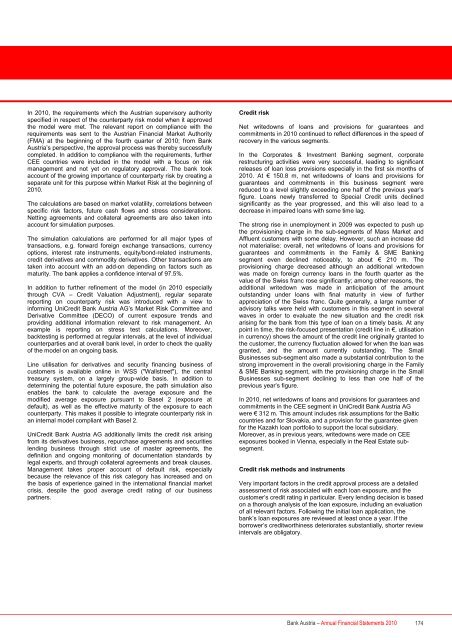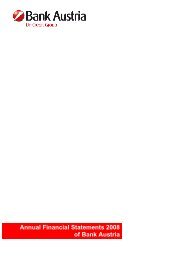Annual Financial Statements 2010 of Bank Austria
Annual Financial Statements 2010 of Bank Austria
Annual Financial Statements 2010 of Bank Austria
You also want an ePaper? Increase the reach of your titles
YUMPU automatically turns print PDFs into web optimized ePapers that Google loves.
Management Report <strong>of</strong> UniCredit <strong>Bank</strong> <strong>Austria</strong> AG<br />
In <strong>2010</strong>, the requirements which the <strong>Austria</strong>n supervisory authority<br />
specified in respect <strong>of</strong> the counterparty risk model when it approved<br />
the model were met. The relevant report on compliance with the<br />
requirements was sent to the <strong>Austria</strong>n <strong>Financial</strong> Market Authority<br />
(FMA) at the beginning <strong>of</strong> the fourth quarter <strong>of</strong> <strong>2010</strong>; from <strong>Bank</strong><br />
<strong>Austria</strong>’s perspective, the approval process was thereby successfully<br />
completed. In addition to compliance with the requirements, further<br />
CEE countries were included in the model with a focus on risk<br />
management and not yet on regulatory approval. The bank took<br />
account <strong>of</strong> the growing importance <strong>of</strong> counterparty risk by creating a<br />
separate unit for this purpose within Market Risk at the beginning <strong>of</strong><br />
<strong>2010</strong>.<br />
The calculations are based on market volatility, correlations between<br />
specific risk factors, future cash flows and stress considerations.<br />
Netting agreements and collateral agreements are also taken into<br />
account for simulation purposes.<br />
The simulation calculations are performed for all major types <strong>of</strong><br />
transactions, e.g. forward foreign exchange transactions, currency<br />
options, interest rate instruments, equity/bond-related instruments,<br />
credit derivatives and commodity derivatives. Other transactions are<br />
taken into account with an add-on depending on factors such as<br />
maturity. The bank applies a confidence interval <strong>of</strong> 97.5%.<br />
In addition to further refinement <strong>of</strong> the model (in <strong>2010</strong> especially<br />
through CVA – Credit Valuation Adjustment), regular separate<br />
reporting on counterparty risk was introduced with a view to<br />
informing UniCredit <strong>Bank</strong> <strong>Austria</strong> AG’s Market Risk Committee and<br />
Derivative Committee (DECO) <strong>of</strong> current exposure trends and<br />
providing additional information relevant to risk management. An<br />
example is reporting on stress test calculations. Moreover,<br />
backtesting is performed at regular intervals, at the level <strong>of</strong> individual<br />
counterparties and at overall bank level, in order to check the quality<br />
<strong>of</strong> the model on an ongoing basis.<br />
Line utilisation for derivatives and security financing business <strong>of</strong><br />
customers is available online in WSS ("Wallstreet"), the central<br />
treasury system, on a largely group-wide basis. In addition to<br />
determining the potential future exposure, the path simulation also<br />
enables the bank to calculate the average exposure and the<br />
modified average exposure pursuant to Basel 2 (exposure at<br />
default), as well as the effective maturity <strong>of</strong> the exposure to each<br />
counterparty. This makes it possible to integrate counterparty risk in<br />
an internal model compliant with Basel 2.<br />
UniCredit <strong>Bank</strong> <strong>Austria</strong> AG additionally limits the credit risk arising<br />
from its derivatives business, repurchase agreements and securities<br />
lending business through strict use <strong>of</strong> master agreements, the<br />
definition and ongoing monitoring <strong>of</strong> documentation standards by<br />
legal experts, and through collateral agreements and break clauses.<br />
Management takes proper account <strong>of</strong> default risk, especially<br />
because the relevance <strong>of</strong> this risk category has increased and on<br />
the basis <strong>of</strong> experience gained in the international financial market<br />
crisis, despite the good average credit rating <strong>of</strong> our business<br />
partners.<br />
Credit risk<br />
Net writedowns <strong>of</strong> loans and provisions for guarantees and<br />
commitments in <strong>2010</strong> continued to reflect differences in the speed <strong>of</strong><br />
recovery in the various segments.<br />
In the Corporates & Investment <strong>Bank</strong>ing segment, corporate<br />
restructuring activities were very successful, leading to significant<br />
releases <strong>of</strong> loan loss provisions especially in the first six months <strong>of</strong><br />
<strong>2010</strong>. At € 150.8 m, net writedowns <strong>of</strong> loans and provisions for<br />
guarantees and commitments in this business segment were<br />
reduced to a level slightly exceeding one half <strong>of</strong> the previous year’s<br />
figure. Loans newly transferred to Special Credit units declined<br />
significantly as the year progressed, and this will also lead to a<br />
decrease in impaired loans with some time lag.<br />
The strong rise in unemployment in 2009 was expected to push up<br />
the provisioning charge in the sub-segments <strong>of</strong> Mass Market and<br />
Affluent customers with some delay. However, such an increase did<br />
not materialise: overall, net writedowns <strong>of</strong> loans and provisions for<br />
guarantees and commitments in the Family & SME <strong>Bank</strong>ing<br />
segment even declined noticeably, to about € 210 m. The<br />
provisioning charge decreased although an additional writedown<br />
was made on foreign currency loans in the fourth quarter as the<br />
value <strong>of</strong> the Swiss franc rose significantly; among other reasons, the<br />
additional writedown was made in anticipation <strong>of</strong> the amount<br />
outstanding under loans with final maturity in view <strong>of</strong> further<br />
appreciation <strong>of</strong> the Swiss franc. Quite generally, a large number <strong>of</strong><br />
advisory talks were held with customers in this segment in several<br />
waves in order to evaluate the new situation and the credit risk<br />
arising for the bank from this type <strong>of</strong> loan on a timely basis. At any<br />
point in time, the risk-focused presentation (credit line in €, utilisation<br />
in currency) shows the amount <strong>of</strong> the credit line originally granted to<br />
the customer, the currency fluctuation allowed for when the loan was<br />
granted, and the amount currently outstanding. The Small<br />
Businesses sub-segment also made a substantial contribution to the<br />
strong improvement in the overall provisioning charge in the Family<br />
& SME <strong>Bank</strong>ing segment, with the provisioning charge in the Small<br />
Businesses sub-segment declining to less than one half <strong>of</strong> the<br />
previous year’s figure.<br />
In <strong>2010</strong>, net writedowns <strong>of</strong> loans and provisions for guarantees and<br />
commitments in the CEE segment in UniCredit <strong>Bank</strong> <strong>Austria</strong> AG<br />
were € 312 m. This amount includes risk assumptions for the Baltic<br />
countries and for Slovakia, and a provision for the guarantee given<br />
for the Kazakh loan portfolio to support the local subsidiary.<br />
Moreover, as in previous years, writedowns were made on CEE<br />
exposures booked in Vienna, especially in the Real Estate subsegment.<br />
Credit risk methods and instruments<br />
Very important factors in the credit approval process are a detailed<br />
assessment <strong>of</strong> risk associated with each loan exposure, and the<br />
customer’s credit rating in particular. Every lending decision is based<br />
on a thorough analysis <strong>of</strong> the loan exposure, including an evaluation<br />
<strong>of</strong> all relevant factors. Following the initial loan application, the<br />
bank’s loan exposures are reviewed at least once a year. If the<br />
borrower’s creditworthiness deteriorates substantially, shorter review<br />
intervals are obligatory.<br />
<strong>Bank</strong> <strong>Austria</strong> – <strong>Annual</strong> <strong>Financial</strong> <strong>Statements</strong> <strong>2010</strong> 174
















